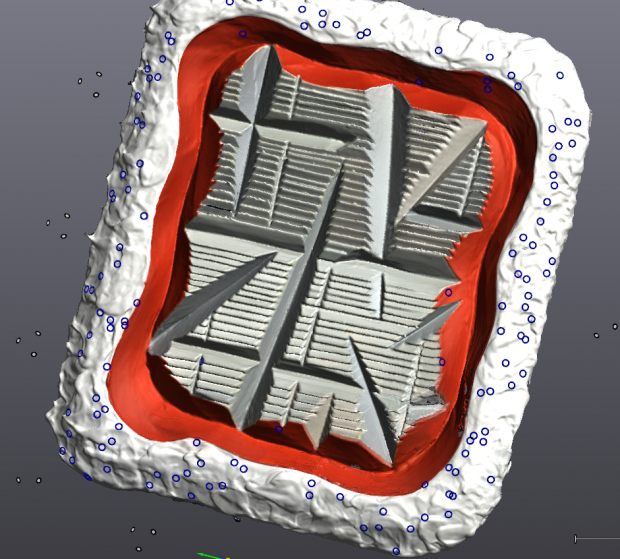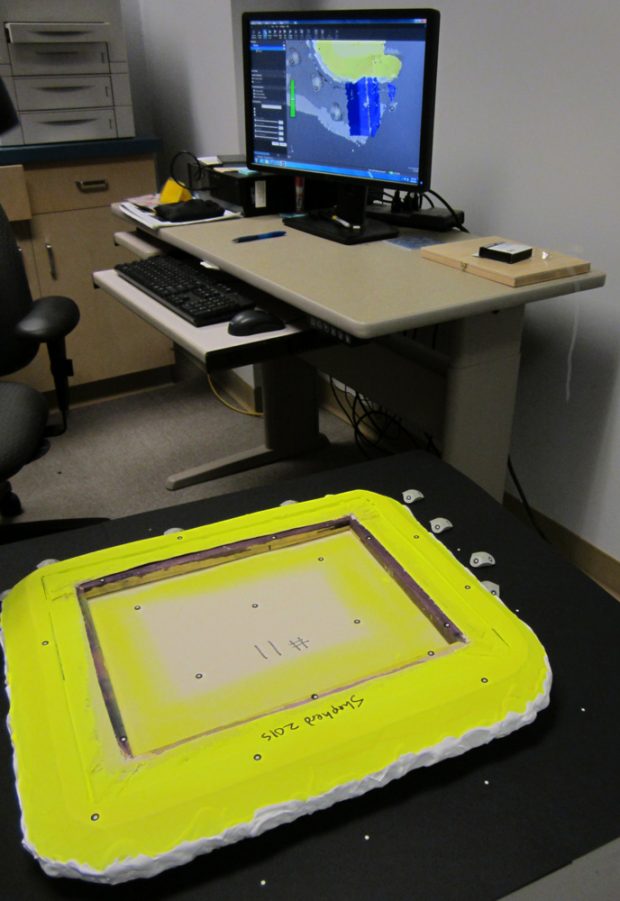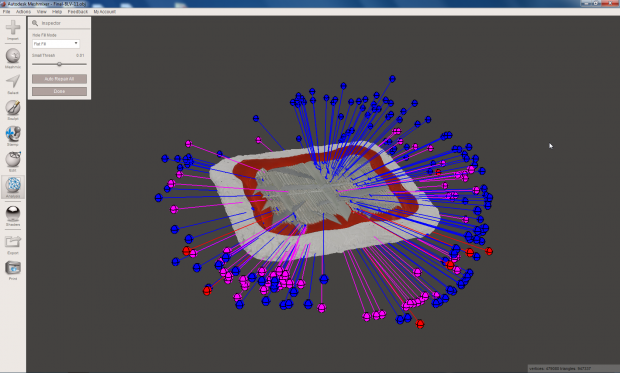
This fall, our department received a request to collaborate with artist Shawn Shepherd using the 3D scanner. He wanted to learn more about the potential for capturing and the possibilities of duplicating or remixing his dimensional artworks. At the right is a screenshot of the piece he chose to work with, as represented on the artist’s portfolio site:
The piece Shepherd wanted scanned was a painting that had a lot of texture to it and I was skeptical about the capabilities of the scanner. The texture in the painting consisted of both straight-edge peaks and valleys in the centre, a deep “moat,” and more fluid “stucco” texture around the outer edge. To my delight, we were able to get a fairly good scan in the end. I scanned the centre area first then each side and finally the underside. Each of these scans were stitched together using the image capture software until a final image could be created. Below is the final merge of the top pieces; you can see one corner edge is still rough but we were able to fill that in when we did the underside:
The first challenge was that the piece was too large to fit on the turntable. We picked up some black poster board to use as the base and placed it over the file cupboard on casters that we repurposed as the 3D scan table. The art fit fairly well on the table.
 Next, we did not want to affix target dots to the textured front of the art (we did eventually use targets on the back of the piece). To compensate, we placed turtle targets beside the edges and used those for triangulation. The software also picked up natural features fairly consistently as there was just enough variation in the edges of the piece. In the image to the right, each of the blue circles is a unique natural feature. As you can see, most are in the peaked edge texture and not the straight-edge centre pieces
Next, we did not want to affix target dots to the textured front of the art (we did eventually use targets on the back of the piece). To compensate, we placed turtle targets beside the edges and used those for triangulation. The software also picked up natural features fairly consistently as there was just enough variation in the edges of the piece. In the image to the right, each of the blue circles is a unique natural feature. As you can see, most are in the peaked edge texture and not the straight-edge centre pieces
 The most difficult portions were the moat, specifically the upper side of the inset area, most of which had to be filled in manually in post-editing. The other challenge was capturing the back of the piece because there was so little variation in colour and texture.
The most difficult portions were the moat, specifically the upper side of the inset area, most of which had to be filled in manually in post-editing. The other challenge was capturing the back of the piece because there was so little variation in colour and texture.
Working with art definitely has its own challenges; each piece is one of a kind and the materials seemed more fragile than many with which we work. I was keenly aware of how we handled it, how it was propped up at certain times to get the right angle, and where the target dots could best be placed. Shepherd was a little more cavalier than I was about placing targets – I reluctantly added them to the back of the piece; we would have had much more trouble without them.
In the past year, we have learned a lot about the strengths and limitations of the Creaform scanner and this was another good test. One completely unanticipated problem we encountered was a breakdown in the equipment — specifically the cable running between the scanner and the computer. The second day of scanning ended up being extremely difficult because of this breakdown as it meant the cable had to be held in a certain way in order for all the wires within to make contact and thus transmit the information. I stubbornly persevered and captured the necessary data but after this project we set aside the equipment until a replacement cable was received (which corrected the issue).
 After doing the capture, and merging the files, we were left with an unwieldy 6.7 GB file. Once we exported it as an object, it was reduced to a fraction of that size, about 147 MB. From there, we imported it into Meshmixer to fill gaps, repair flaws, and basically correct any major flaws. To give you an idea of the number of these flaws in the image capture, each of the dots and lines in the image below corresponds to a correctable flaw.
After doing the capture, and merging the files, we were left with an unwieldy 6.7 GB file. Once we exported it as an object, it was reduced to a fraction of that size, about 147 MB. From there, we imported it into Meshmixer to fill gaps, repair flaws, and basically correct any major flaws. To give you an idea of the number of these flaws in the image capture, each of the dots and lines in the image below corresponds to a correctable flaw.
The goal is to make the model watertight so that it can be printed. Most of these can be done using the single “auto repair all” button — some require greater finesse. After the repair, the final object and its corresponding files (including the Bitmap of the texture) may then be zipped and uploaded for display online.
At the artist’s request, the final 3D version of this file has not been uploaded to our collection.
Update! In the January 2018, the artist returned to the Digitization Lab with some examples of the objects he had been able to make using a CNC machine. The reproductions are smaller in scale than the original but maintain the texture. The artist created three reproductions, each painted differently.

